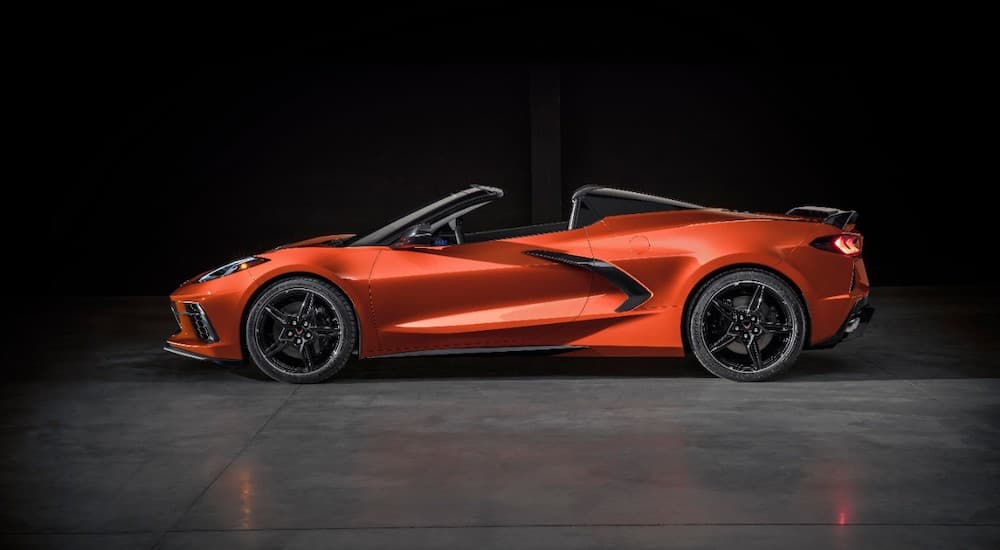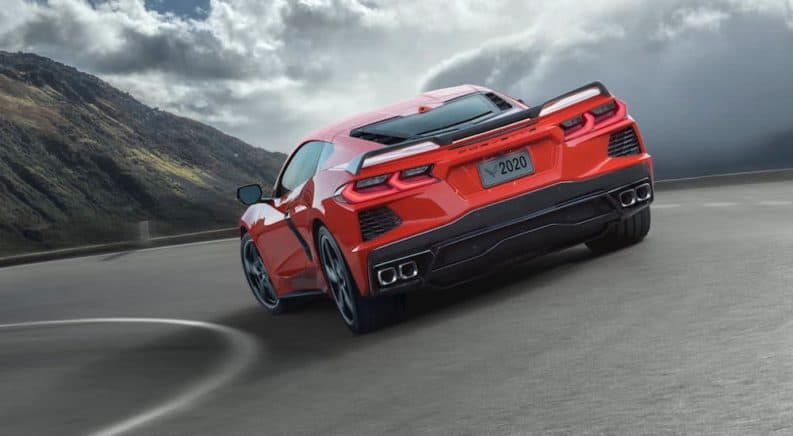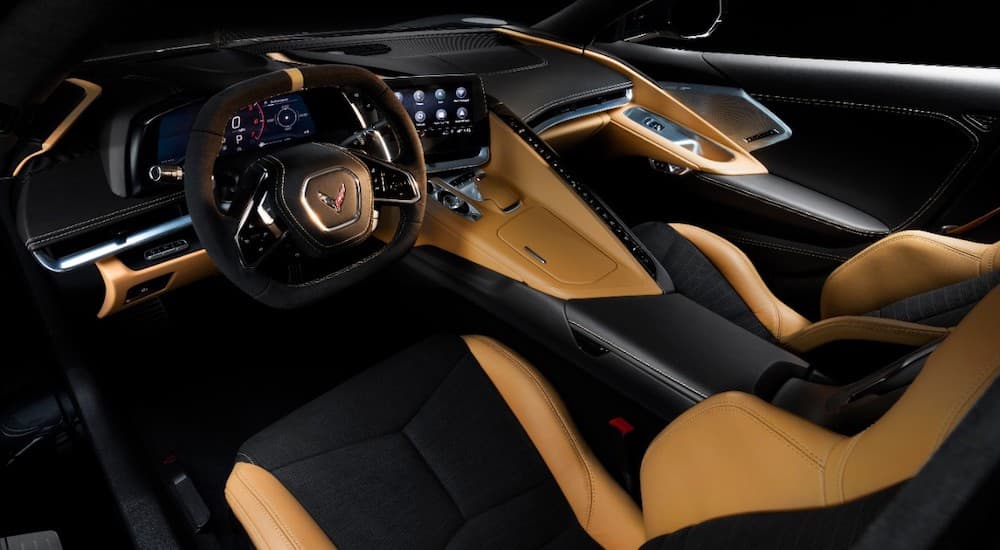Chevy has been inciting mass anticipation in the Corvette community for decades with a potential mid-engine Corvette. Motor Trend magazine has featured concept designs of a mid-engine Corvette since 1969. As of July 18th, 2019, official news finally arrived for the mid-engine 2020 Chevy Corvette. With the rear window for the V8, terrifyingly sharp headlights, a pointy hood, and wide scoop vents; is what’s next for Corvette what’s best for it?
What’s New?
Issuing-in the eighth-generation Corvette (C8), this American wheeled warrior was born with dual fuel tanks, wind-splitting edges, and an engine where it’s never been before.
Capable of 495 hp, 470 lb-ft of torque, and standard with a removable body panel for inconspicuous convertible capability, is the all-new 2020 mid-engine Chevy Corvette Stingray, starting at $59,995.
While Chevy has not come out with every minuscule detail for the new generation of the Corvette Stingray, they’ve offered enough for me to begin clearing out the garage and start saving more of my pennies. The futuristic drawings inside of our chemistry notebooks of racecars with tall back-ends, plunging front-ends, and dramatic curves come to life in the 2020 Corvette.
With evolved taillights, a plunging nose, better handling, and a faster 0-60 time than the 2019 ‘Vette, you’ll have a hard time deciding what you like better: driving or looking at the 2020 Corvette Stingray.
It’s hard to believe that for the price of ~$60k, you can be driving a supercar lookalike. Add to it that this car is American made, and you can already see your childhood dreams come within arm’s reach.
Perhaps I’m being a bit dramatic about the all-new Corvette. But consider the facts. Like today’s exotic, foreign-manufactured sports and supercars, it exhibits the cold, confident exterior of a mid-engine vehicle. It comes standard with a 6.2L V8, capable of 495 hp and 470 lb-ft of torque. It reportedly travels 0-60 mph under 3 seconds.

Performance Specs
Corvette designer and engineer Alex MacDonald claim that part of the reason Chevy did not feel a need to include a manual transmission was because of the hyper-responsive paddle shifters in the 2020 Corvette. This 8-speed dual-clutch transmission features shifters behind the steering wheel.
The former 6.2L 8-cylinder known as the LT1 has gained obvious modifications since its move. While the 2020 Corvette’s engine remains a small block 8-cylinder engine with a displacement of 6.2L, it packs a heavier punch than the LT1. With a 0-60 MPH time in under 3 seconds, compared to the 2019 model’s 3.7 seconds, the 2020 ‘Vette is now capable of even more horsepower and torque. Not to mention, the new configuration and drastic redesign of the Corvette is certainly affecting its performance as well.
The Significance of Mid-Engine Placement
With considerably more weight in the rear of the car, the downward force of the engine and fuel tank on the rear axle and wheels offers more brake control and responsiveness than the years’ previous.
The same can be said for acceleration. With the increase of mass above the rear axle, and the LT2’s high torque capacity to move the wheels under the added force, the friction the wheels create once they are moved improves acceleration times. For instance, in an interview with Car and Driver magazine, Chevy designers commented that the 2020 Corvette Stingray with the Z51 package can move 0-60 M.P.H in under 3 seconds, while we know the 2019 Corvette Stingray with the Z51 package moved 0-60 M.P.H in 3.17 seconds. The C8 also is capable of 35 more hp and 5 more lb.-ft. of torque than the C7 (7th generation Corvette).
Finally, the engine in the rear of the vehicle allows the Corvette to be more agile around turns. On the handling side of things, the mid-engine component of the 2020 Corvette reduces the car’s ability to resist sideways movement. Because there is less weight in the nose of the car, and more weight in the middle of it, the 2020 ‘Vette will grip the road much better than it has before.
Interior
While the debate will roll-on over Chevy’s makeover to the new generation of the Corvette, the decision has also brought more attention to the driver than ever before.
With a redesigned steering wheel, a display designed only for the driver to use, and a Jetson’s-era strip of buttons that encloses the driver in their own cockpit, so-to-speak, Chevy chose to pay careful attention to the needs of the driver in 2020.
Road visibility has drastically improved. The empty space where a V8 used to be, brings the driver 16.5 inches closer to the front of the car. Because the hood no longer houses an engine, it takes a more dramatic angle toward the road. The driver can see much more of the road than she or he ever could have before. While your seat in the new ‘Vette will feel closer to the road, Chevy boasts that moving in and out of the new Corvette won’t be less of an ordeal than before.
After you sit down, take a look at the new flattened steering wheel. In 2016, Chevy introduced a flat bottomed steering wheel in its Corvette. Now, the top of the wheel is flat, as well. Almost as if flattened only on the top and the bottom, you won’t be using a full wheel behind a Corvette anymore. The perk? You now have an unobstructed view of the gauge cluster. Maybe this is something we can get used to…
While you may feel like Chevy just can’t hold back on all of the changes, consider this: the new display is directed completely at the driver. The location and angle of the infotainment display offers the driver an easy transition from the road to the screen. Although Corvettes in the past have oriented their screen toward the driver, 2020 brings with it a more generous angle toward the driver.
On the passenger side, a wide sloping, leather dashboard will restrict the passenger’s view of the screen to nearly 100%.
What may be most jarring for some drivers is the descending strip of buttons, one per row, that form a distinct division between the driver and passenger. This strip of buttons will still allow the passenger to manipulate their own climate preferences, as well as utilize heated and ventilated seats on their own.
The Corvette also sports a front and rear trunk. The rear trunk has enough room for the removeable top, or a small bag, while the front trunk is slightly smaller.
After all, Chevy has sent a message to its loyal customers and admirers that the Corvette is meant to drive for a long time. The attention to detail on the interior, as well as an increased shift in performance on the pavement, will help any driver get over the new engine layout.





